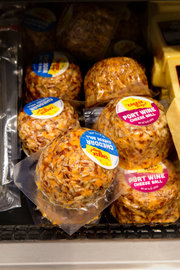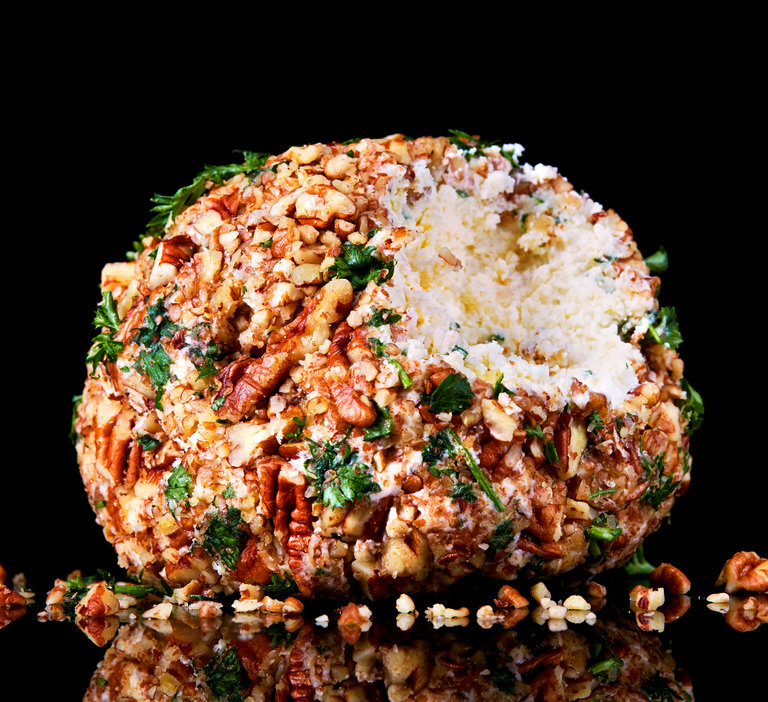A cheese ball is the culinary equivalent of a Rorschach test. How you regard the creamy orb depends very much on where you were raised, how you were raised and — especially when facing one of the lesser examples — your emotional fortitude.
A colleague suggested that a cheese ball is one of those things her European parents would point to and say, “Americans will never understand food.†They are clearly not from the Midwest, where cheese balls are as much a part of the culinary lexicon as fish fries, hot dish and brats.
“I can’t imagine you would go to a cocktail party and not see one,†said Robin Davis, who works for the mayor of Columbus, Ohio, and for years was the food editor of The Columbus Dispatch, that city’s daily newspaper.
Part of the appeal is history (more on that in a moment) and part of it is practicality. A cheese ball demands very little of a cook. “It’s not a culinary commitment,†Ms. Davis said, “and it travels well.â€
In its purest form, a cheese ball is a mixture of sharp shredded cheese like Cheddar or blue, blended with cream cheese and, often, butter. It’s usually seasoned with anything in the allium and capsicum (pepper) families, then rolled in a mixture of nuts and herbs. It’s great spread on crisp, plain crackers and goes really well with a drink.

December is the Olympics for cheese ball fans. The treats populate dairy cases in many parts of the country in flavor varieties that rival their brethren in the ice cream case. Sharp Cheddar and port wine may be the standard-bearers, but things can get crazy out there in cheese ball land.
Cheese balls seasoned with Worcestershire sauce and rolled in chopped dried beef from Buddig, a popular supermarket brand, are big at Ohio potlucks, Ms. Davis said. In Texas, a jalapeño-bacon cheese ball is often on the cocktail party buffet. Williams-Sonoma offers a recipe for a Cheddar cheese ball smoothed with mayonnaise, flavored with smoked paprika and rolled in poppy seeds.
There are cheese ball recipes engineered to taste like Buffalo chicken wings, Hawaiian pizza, bruschetta and an everything bagel with a schmear. They are formed into turkeys with pretzel sticks for tails, or into pine cones with whole almonds for the scales. Cats, owls, footballs: The cheese ball is a blank canvas for both the home craftmaker and the satirist.
The comedian and writer Amy Sedaris elevated cheese ball kitsch to an art form when she made her Lil’ Smoky Cheese Ball with a smoked Gouda and steak sauce on Martha Stewart’s show several years back.
She featured the recipe in her 2006 book “I Like You: Entertaining Under the Influence,†and she and her brother, the writer David Sedaris, even wrote a play titled “The Book of Liz†that centers on a woman from an Amish-like sect whose cheese balls sustain the community. It inspired The New York Times theater critic Ben Brantley, who reviewed the play in 2001, to open with the line “Isn’t it wonderful what a nimble set of hands can do with a simple cheese ball?â€
To truly understand the cheese ball, one has to dig into its roots. There you will find cold-pack cheese, also known as club cheese or crock cheese, which began as a snack in Wisconsin taverns and supper clubs around the turn of the last century.
Taking a cue from British and Scandinavian cooks, whose culinary traditions included packing odd bits of cheese ground with seasonings and perhaps a little alcohol into jars or crocks and preserving it with a layer of butter,tavern owners worked cheese and cream together to make a spread that unlike its later cousin, processed cheese, did not require heat to blend. It went well with beer. They sometimes packed it into crocks to give to customers as gifts, according to the Center for Dairy Research at the University of Wisconsin-Madison.
From the bar stool sprang an industry that grew to include cheese balls and logs. The United States Department of Agriculture estimates that almost 40 million pounds of processed cheese is produced each year, with Wisconsin accounting for 77 percent of it.
With its Cheddar tang and unchallenging pleasure spread across a buttery Town House cracker, cold-pack cheese was a muse to Brett Kell, who wrote about his first taste in the magazine Edible Milwaukee.
“I remember it like one remembers a first kiss, first joint or first shot of liquor,†he rhapsodized. “Totally foreign, slightly confusing, and worth another taste.â€

There are other indications of a cheese ball revival. In 2013, Michelle Buffardi, a Martha Stewart Living alumna, published “Great Balls of Cheese,†with more than 50 recipes on the theme, both sweet and savory. MplsStPaul Magazine declared 2016 “the year of the cheese balls†in an article by Dara Moskowitz Grumdahl, who posited that the dish is the North’s answer to Southern pimento cheese, which has been enjoying something of a star turn itself.
The cheese ball resurgence is not confined to the North. At the Cheese Board Collective, the pioneering cheese shop and bakery in the Berkeley, Calif., neighborhood that spawned Chez Panisse and Peet’s Coffee, a seasonal cheese ball made of Cheddar and blue cheese and rolled in walnuts sells out regularly at $20 a pound.
The cheese ball has even drifted south. The chef and television personality Vivian Howard included a recipe in her new book “Deep Run Roots,†a comprehensive, thoughtful study of the food and culture of North Carolina’s coastal plain. The book has more than 200 recipes, yet to her bewilderment, her Party Magnet cheese ball has drawn more media attention than any other.
To be sure, it’s an excellent example of the genre, with blue cheese, dates and buttered pecans that she suggests you roast yourself. On her PBS show, “A Chef’s Life,†she makes a version that she rolls in dried ham chips.
The book’s version is a little easier. “The person who is going to pull out the cheese ball recipe is not going to dehydrate ham chips,†Ms. Howard said.
For all of the cultural baggage the cheese ball carries its appeal isn’t that hard to decipher.
“It’s something everybody has a connection to,†she said, “whether you want to admit it or not.â€
By Kim SeversonÂ







